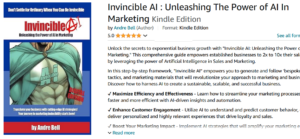 Have you ever dreamed of writing a book to leave a lasting legacy, attract potential clients, or simply find a fulfilling creative outlet? If so, you’re not alone. Many aspiring authors struggle with the process, facing the daunting challenge of writer’s block or, even worse, wondering how to get started in the first place.
Have you ever dreamed of writing a book to leave a lasting legacy, attract potential clients, or simply find a fulfilling creative outlet? If so, you’re not alone. Many aspiring authors struggle with the process, facing the daunting challenge of writer’s block or, even worse, wondering how to get started in the first place.
Earlier this week, during a conversation with me, a surgeon mentioned he had been working on writing a book for some time. As I was about to undergo a procedure and was focused on the potential outcome, detailing the steps for quickly hammering out a non-fiction book and avoiding writer’s block was the last thing on my mind. However, during the return trip home, my mind kept nudging me to share the streamlined approach many professional writers use to hammer out a non-fiction book and overcome common writing obstacles.
Writing a non-fiction book in a week, or finishing a book in a week that you’ve already started, might sound daunting or even unrealistic. Nevertheless, with a structured approach, you can achieve it. Here’s a step-by-step guide to help you reach this ambitious goal. And yes, AI plays a role in this process.
Here’s an outline of the steps to help you get started.
Step 0: Decide How You Want Your Book to End
A big mistake most people make in their quest to write a book is struggling with how to start. That approach is wrong. Instead, begin with the end in mind, not the beginning. Consequently, starting with the end in mind gives you a direction to reach and eliminates writer’s block because you already know at the outset where you want to go and where you want to end.
Step 1: Make a List of 18 Primary Topics
First, brainstorm a comprehensive list of 18 primary chapter topics related to your book idea. These topics will form the foundation of your chapters, covering all essential aspects of your subject.
Step 2: Excise the Three Weakest Topics
Next, review your list and remove the three least compelling or relevant topics. This will leave you with 15 strong topics to focus on. Each topic will become a separate chapter. But don’t begin writing just yet. Instead, move to the next step.
Step 3: Develop Subpoints for Each Topic Chapter
Then, for each of the remaining 15 chapter topics, list 18 subpoints. These subpoints will serve as the key details and supporting information for each chapter.
Step 4: Excise the Three Weakest Subpoints
Again, review each list of subpoints and remove the three weakest or least relevant ones. This process helps you refine your content and ensures each chapter is packed with valuable information.
Step 5: Use Remaining Subpoints to Outline First Chapter
Next, use the remaining 15 subpoints for each topic as guidelines, roadmaps, or outlines to help you determine what to include as you write each chapter. Therefore, write the first chapter using the 15 subpoints to direct your content. This structured approach will keep your writing focused and coherent.
Step 6: Repeat for Each Chapter Until Your Draft Is Completed
Now, move on to the next chapter and repeat the process until you complete all chapters. Consistency is key, and this method ensures you thoroughly develop each chapter. You now have the rough ‘guts’ of your book completed.
Step 7: Write a Preface
Afterward, write a preface to set the stage for your readers. Explain the purpose of your book, your motivation for writing it, and what readers can expect to learn. Keep it engaging and concise.
Step 8: Write a Foreword
Next, write a foreword, often written by someone else, to provide context and credibility. If you can, invite an expert or a respected figure in your field to write this section. If not, truth be told, you can write it yourself, providing an overview of the book’s significance. This is what most authors do. Then they ask a trusted expert or peer to review the forward, make changes, and ‘sign’ the forward as their own. This saves time waiting weeks and months for someone else to ‘get back to you’ about your request for a forward.
Step 9: Write an Afterword
Then, write an afterword to offer a chance to reflect on the book’s creation and its broader implications. Share any final thoughts, insights, or acknowledgments.
Step 10: Print and Upload a PDF of Your Draft
Once your manuscript is complete, print and upload a PDF version to your Google Drive. This step ensures you have a backup and can easily share your book for review and feedback. Most importantly, you are making your book available for AI to access remotely. Keep reading to learn what to do next.
Step 11: Install a PDF Reader to Your Preferred AI Account
Next, install a PDF reader tool to your preferred AI account to facilitate the review process. This will allow AI to remote proofread and edit your entire book. Most subscribed AI tools have a word count limit. Rarely so when remotely reading a PDF.
Step 12: Use Your Preferred AI Tool for Grammar, Spelling, and Punctuation
Then, briefly tell your preferred AI tool what you are writing about and who your targeted audience is, and ask AI to remotely access and read the PDF version of the book you uploaded to your Google Drive and evaluate language style appropriate for your audience, and check for grammar, spelling, and punctuation errors. AI can efficiently identify and correct mistakes remotely the same as a human editor, saving you time and effort. And often, money.
Step 13: Use Your Preferred AI Tool for Logical Consistency and Content Errors
Next, have your preferred AI tool review your book for errors in reasoning, omissions, and commissions. This step ensures your content is logically sound and comprehensive.
Step 14: Review Chapter Order
Subsequently, ask your preferred AI tool if the order of the chapters is sufficient or if a different order is suggested. AI can provide insights into the flow and structure of your book, enhancing readability. You can do the same on individual chapters if so inclined. You tell AI your targeted 15 subpoints for the chapter and ask if the order is sufficient or if the order needs changing.
Step 15: Proofread Your Book
Despite AI assistance, a final human proofread is essential. Carefully read through your entire book beginning to end to catch any remaining errors and ensure everything is perfect. Yes, AI can make mistakes or misunderstand your intent.
Step 16: Ask Your Preferred AI Tool for Book Cover Suggestions
Then, ask your preferred AI tool to suggest a list of at least ten book cover ideas suited to your topic and target market. Make sure to tell your AI do not create the covers. At this point you only want to mentally visualize design options that might best represent your book. You do not want AI skewing your imagination while you are still thinking of ideas.
Step 17: Generate a Mockup of Your Book Cover
Next, read through the list of ideas and select the suggestion you like most and ask your preferred AI tool to generate a mockup of that idea with cover, spine, and back cover for a 5×8 or 6×9 paperback, and 6×9 hardcover book. These mockups will give you a clear idea of what your finished book might look like and help you make any necessary adjustments.
Step 18: Hire a Book Cover Artist
Using your mockup as an idea jump starter, contact a Fiverr book cover artist to create your book cover, back, and spine for you. Make sure to communicate to your prospective artist that your mockup is just an idea and you are open to other approaches suggested by the artist.
Step 19: Format Your Text
Additionally, your text must be professionally formatted to match the layout of your book. A professional designer (I recommend Fiverr) will match your text to the size book you are publishing as well as add design elements to the pages a novice most likely will not know to add.
Step 20: Publish
Finally, once you’re satisfied with your manuscript and book design, it’s time to publish. Whether you’re self-publishing or working with a publisher, follow the necessary steps to bring your book to the world. Oh. A publisher may require a greater number of chapters than just 15 chapters. In that case, expand the number of chapters by following this same approach until you have the required number of chapters completed.
By following this structured approach, you can write a non-fiction book in just a week. However, if you are super lazy (and unconcerned about ethics) you can manipulate AI to do all of the heavy lifting for you. By applying a few extra steps you can force AI to use this process to turn out a high-quality (nut a junk) book for you in a weekend–or even a day–without you doing much more than proofreading the output for AI’s accuracy in understanding your intent. Maybe I’ll explain how to do that in some other post.
Till then, stay focused, use the tools at your disposal, and you’ll have a polished, professional book ready for readers in no time. Additionally, if you are self-publishing through Amazon, you can use your digital book to create a paperback, a hardcover edition, and Amazon KDP digital exclusive, thus creating three sources of income from a single book. Furthermore, if your book takes off, you can hire a Fiverr voice artist to record an audiobook version of your book. Consequently, you will then have a fourth income source from the same work. Sweet!
Step XX: Finito ??
The last step is to promote your work. However, promoting your book is an entirely separate beast and needs to be attacked in some other resource. Nevertheless, at least the book is finished. Therefore, pat yourself on the back and enjoy the success of finishing what you dreamed of creating and what you may have started but not finished until now. I’m speaking from experience here. Specifically, I’ve assisted in ghostwriting a number of works as well as used these processes for editorial content of my own. Hence, you now know these steps are not hypothetical. They work!
By the way, if you are considering hiring a ghostwriter for your next non-fiction work, from time to time I make myself available for interesting projects. Contact me. Tell me about the subject. If it is interesting and if I am available I’ll let you know. However as a matter of transparency I prefer to create content that makes cash registers ring—marketing action plans, marketing strategies, marketing tactics, sales copy and other marketing deliverables. Helping businesses grow is my preferred activity. Perhaps we can do a little of both. Either way I wish you well in your writing endeavors.



